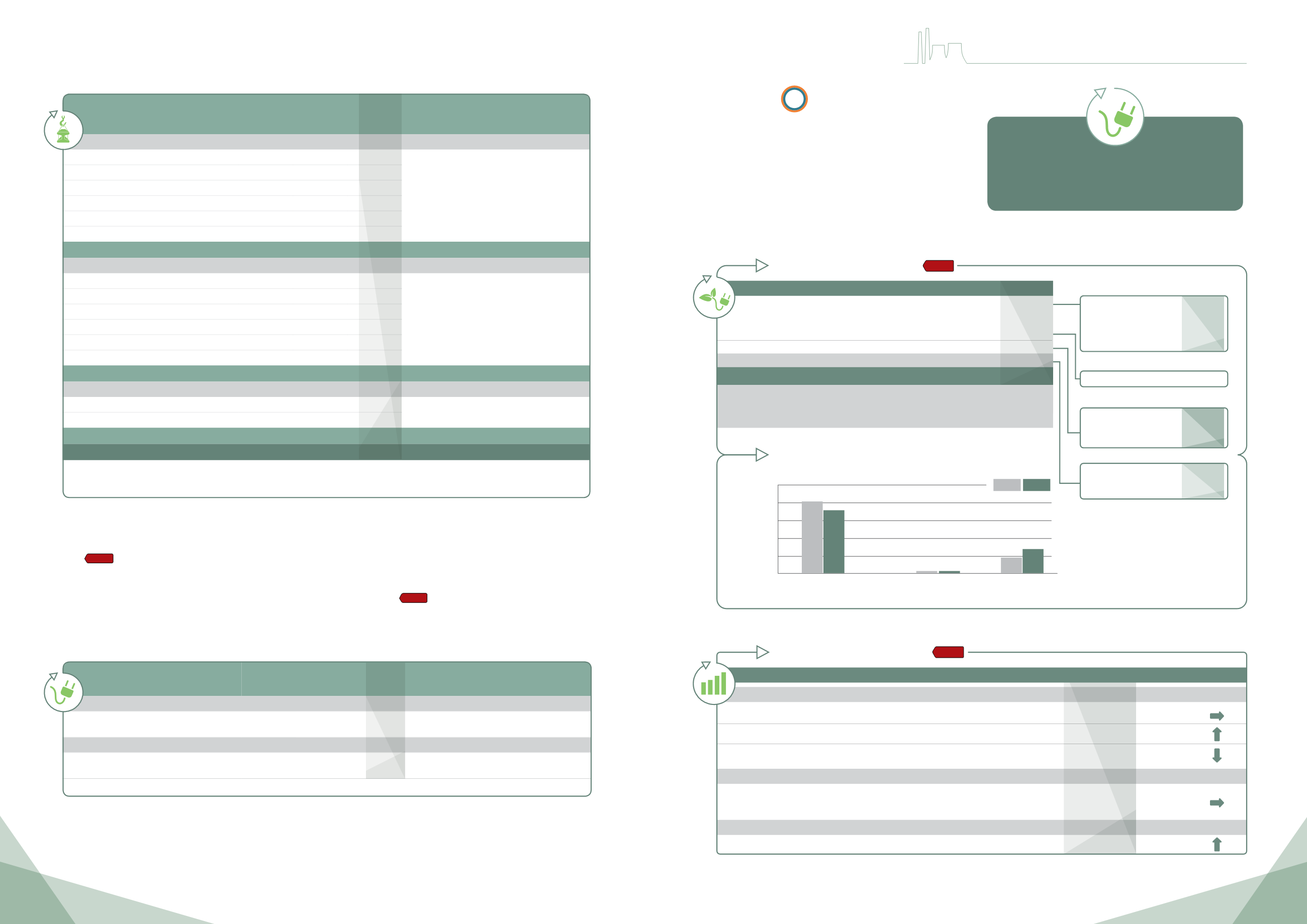
28
29
MYTILINEOS HOLDINGS SUSTAINABILITY REPORT
2015
8.3 Energy
The total consumption of energy at the Group’s industrial plants
in 2015 stood at 35,954.58 TJ. This quantity was obtained from
non-renewable sources only and posted a 12.9% increase com-
pared to 2014, mainly due to the increased participation of the
thermal power plants of Protergia in the wholesale electricity
market. The consumption of electricity rose by 3.9%, while the
consumption of energy from fuels (mainly natural gas) rose by
16.5%.
2014
2015
31,835.75
Total
35,954.58
Energy consumption (Non-renewable sources)
Energy consumption (Renewable sources)
Energy purchased for consumption
Energy produced
Energy exported (sold)
*Total energy consumption
= Energy consumption from Non-renewable sources +
Energy consumption from Renewable sources + Energy purchased for consumption +
Energy produced – Energy sold.
20,960.01
0
9,760.45
8,361.90
7,246.61
24,408.95
0
10,138.76
10,457.77
9,050.88
2014
2015
Change
Specific Consumption - bauxite production
(GJ/t of bauxite produced)
Specific Consumption - alumina production
(GJ/t of alumina produced)
Specific Consumption - aluminium production
(GJ/t of aluminium produced)
METALLURGY & MINING SECTOR
0.1
8.5
66.3
0.1
10.5
53.9
-
23.5%
-18.7%
Specific product consumption
(GJ of natural gas consumption/GJ of electricity production)
ENERGY SECTOR
-
1.87
-
Specific consumption - processed metal (GJ/t)
EPC PROJECTS SECTOR
16
17
6.25%
Table of energy intensity figures
Natural gas (Tj)
24,075.58
Fuel oil (Tj)
308,45
Diesel oil (Tj)
18.37
Heating oil (Tj)
1.26
Petrol (Tj)
5.29
Electricity
IPP (Tj)
1
4,413.24
CHP (Tj)
2
4,187.64
RES (Tj)
3
450,00
1
: : IPP (Thermal plants),
2
: CHP (Combined Heat and Power Plant),
3
: RES (Renewable Energy Sources)
2014
2015
100%
80%
80,5%
73,5%
26,3%
19,3%
0,2%
0,2%
60%
40%
20%
0%
Metallurgy &
Moning Sector
EPC Project
Sector
Energy
Sector
Percentage of energy consumption by activity sector
IPP (Tj)
1
4,534.01
CHP (Tj)
2
5,473.76
RES (Tj)
3
450,00
Total energy consumption (Tj)*
G4-EN3
G4-EN5
Group policy on responsible management of energy:
9
17
15
20
23
24
25
26
27
29
30
28
21
10
11
22
12
13
18
16
14
19
EPC PROJECTS
SECTOR
2013
2014
2015
Measurement
method
Origin of supplies
Type and weight of Materials (not incorporated in the end product) (tonnes)
Oxygen**
99
102.5
104.6
Direct measurement
External supplier
Welding gases (Argon & Nitrogen)**
67
81.3
114.7
Carbon dioxide*
17
18.2
17.3
Acetylene*
2.5
3.6
5.1
Liquid coolant*
3
3.5
5.5
Mineral oils*
0.7
1.5
0.8
Subtotal (1)
189.2
210.6
247.9
Type and weight of semi-finished products (not incorporated in the end product) (tonnes)*
Steel, in plates / merchant bars
320
355
226.1
Direct measurement
External supplier
Special materials for projects
20,058
(pcs)
302
181.2
Welding materials
14
21
32.7
Paints
7,591
(lt)
6
24.8
Connection materials
47,136
(pcs)
5.5
1.5
Solvents
-
2
6.4
Subtotal (2)
-
691.5
472.9
Type and weight of Packaging materials (tonnes)**
Nylon
2
2.3
2.3
Direct measurement
External supplier
Tarpaulin
600
(m2)
0.2
0.1
Subtotal (3)
-
2.5
2.4
Total (1+2+3)
-
904.6
723.2
*From Non-Renewable Sources
** From Renewable Sources
ENERGY
SECTOR
2013
2014
2015
Measurement
method
Origin of supplies
Type and weight of Raw Materials*
Natural gas (TJ)
23,444.18
6,059.9
9,338.4
Direct measurement
External
supplier
Type and weight of Materials (not incorporated in the end product)*
Lubricating oils (lt)
9,399.5
8,213.0
8,333.0
Direct measurement
External
supplier
* From Non-Renewable Sources
The percentage of the use of recycled materials in the imple-
mentation of projects in the EPC Projects Sector in 2015 stood at
34%
1
G4-EN2
. Additionally, a key criterion in the design stage of
the projects that METKA is carrying out as an EPC Contractor is
the maximum possible use of recyclable materials. The compa-
ny’s requests for proposals and the contracts with suppliers of
materials and equipment contain a specific clause regarding their
compliance with the requirements of the ISO-14001 International
Standard, specifically referring to the prohibition of using envi-
ronmentally hazardous materials and the obligation to make the
maximum possible use of recyclable materials.
In the
Energy Sector
, the raw material used in the Group’s power
plants is natural gas, which cannot be recycled and is not a re-
newable source.
G4-EN2
In 2015, the consumption of natural gas at
the thermal power plants of Protergia grew by 54.1% compared to
2014, due to the increase in the production of electricity.
1
Of the 471.98 tonnes of total weight of materials used and incorporated in the end products, steel (in the form of plates, merchant bars or other project
materials) accounted for approximately 400.93 tonnes. Around 40% of the EU’s total steel production comes from electric arc furnaces, in which steel is


